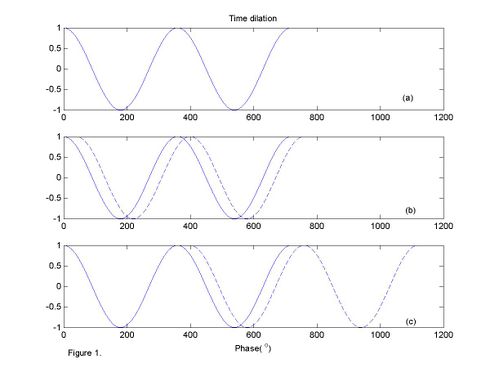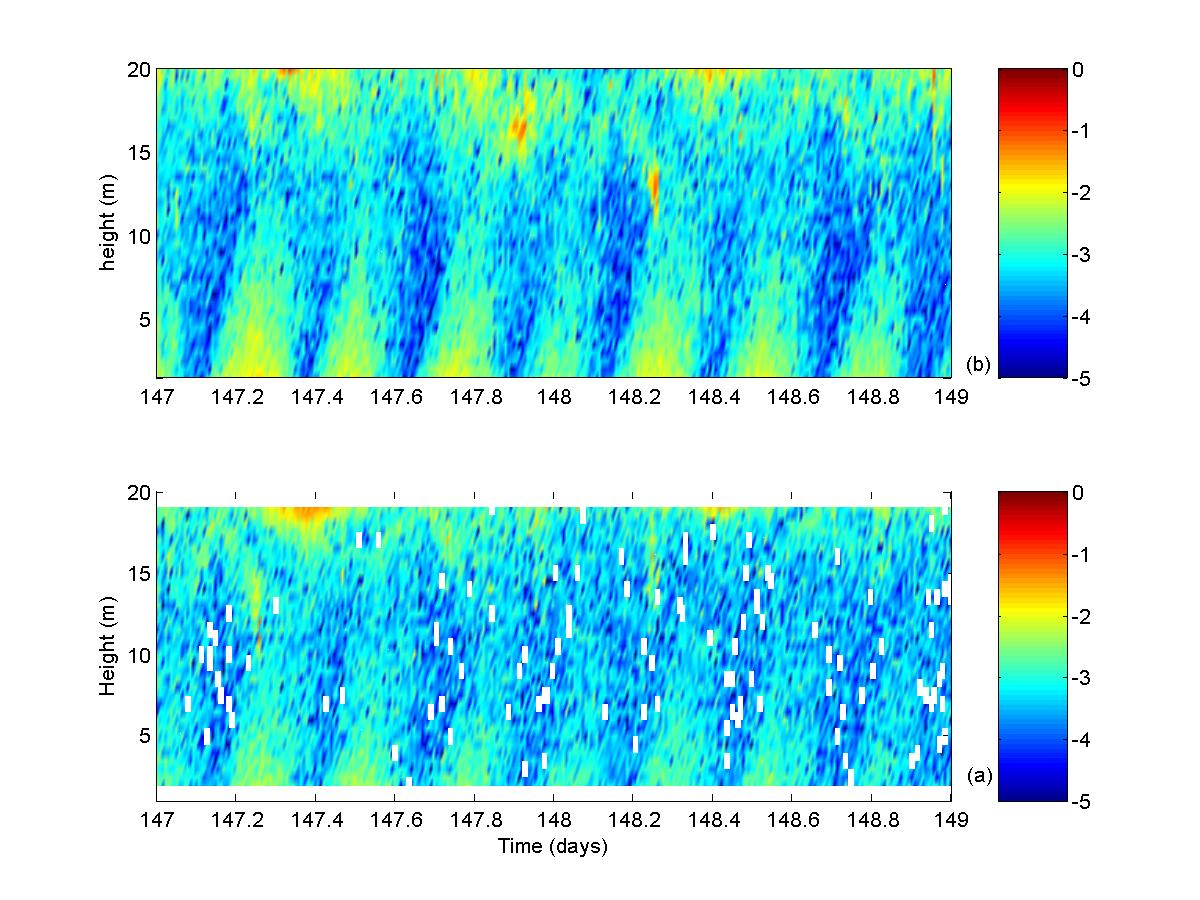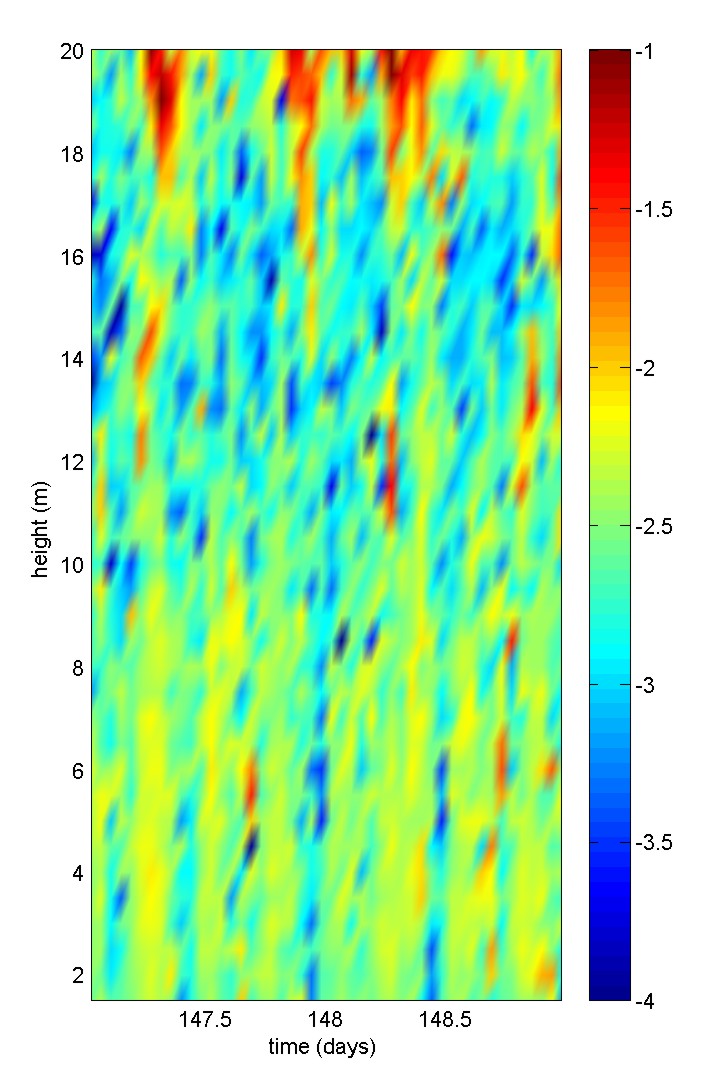Difference between revisions of "Currents and turbulence by acoustic methods"
Cliviahaese (talk | contribs) m |
Cliviahaese (talk | contribs) m (→Broadband and coherent techniques) |
||
| Line 26: | Line 26: | ||
If we send a pulse of sound to a stationary particle, the echo from this pulse of sound will result the same (Figure 1a). If the particle moves away from the transmitter it will take longer to the sound to go back and forth (Figure 1b). This change in travel time cause by the distance travelled is called propagation delay. | If we send a pulse of sound to a stationary particle, the echo from this pulse of sound will result the same (Figure 1a). If the particle moves away from the transmitter it will take longer to the sound to go back and forth (Figure 1b). This change in travel time cause by the distance travelled is called propagation delay. | ||
| − | [[Image:Timedilation.jpg]] | + | [[Image:Timedilation.jpg|thumb|left|490px|]] |
Echoes from a particle always look the same when the particle does not move, i.e. there is no propagation delay. Echoes have the same relative phase which means zero phase change. In the case of superimposing a second echo on a particle moving away from the transducer, we have that the second echo would be delayed with respect of the first one. I the case of the example shown in figure 1a, the delayed echo shown as a dashed line, has a phase delay of 40<sup>o</sup>. A propagation delay corresponds to a change in distance, so if we measure the delay and we know the speed of sound we can estimate how much the particle has moved and because we know the time lag between pulses we can calculate the particle velocities. | Echoes from a particle always look the same when the particle does not move, i.e. there is no propagation delay. Echoes have the same relative phase which means zero phase change. In the case of superimposing a second echo on a particle moving away from the transducer, we have that the second echo would be delayed with respect of the first one. I the case of the example shown in figure 1a, the delayed echo shown as a dashed line, has a phase delay of 40<sup>o</sup>. A propagation delay corresponds to a change in distance, so if we measure the delay and we know the speed of sound we can estimate how much the particle has moved and because we know the time lag between pulses we can calculate the particle velocities. | ||
Revision as of 15:44, 24 July 2007
Contents
- 1 Introduction
- 2 Broadband and coherent techniques
- 3 Three dimensional velocities.
- 4 The variance method to calculate Reynolds stresses, turbulence production, eddy viscosity and drag coefficients
- 5 The structure function method to estimate ε.
- 6 An example of observations of turbulence measurements
- 7 Conclusions
Introduction
Acoustic Doppler current meters (Velocimeters & Profilers) are used to measure currents in the ocean; the original idea as its name stands is to use the Doppler shift to calculate velocity. The Doppler shift is the observed change of sound pitch as result from relative motion. An example of Doppler effect is the sound made by a vehicle approaches, i.e. a car has a higher pitch as it approaches and lower as it goes away. This change in pitch is proportional to how fast the vehicle is moving (this the same technique used by speed cameras and speed guns used by police). So if we can measure how much the pitch changes we can measure how fast the vehicle goes.
The speed of sound is:
[math]C=F\times\lambda[/math]
The Doppler shift is the difference between the frequency when there is no movement and the difference when either the target or the source or both are moving and is:
[math]F_D = F{C \over V}[/math]
where F the sound frequency, λ is the sound wave length , FD is the Doppler Shift, and V is the is the relative velocity between source and receiver.
In the case of all the acoustic Doppler profilers and current meters (but not velocimeters) the transducer works as both a transmitter and a receiver, so that the equation changes to:
[math]F_D = 2F{C \over V}[/math]
So if we know the original frequency and velocity of sound we can measure the frequency change and infer the along sound (beam) velocity. Because we can only measure the along beam velocity instruments have 3 or 4 transducers, so that the 3 velocity components can be measured. The problem of this technique is that each along beam velocity is going to be measuring a different part of the water so we have to assume that the velocity movement is the same within that area.
All comercial Doppler profilers and current meters (not the velocimeters) are capable to use this technique (Narrow Band). This are the most popular instruments available:Teledyne RD InstrumentsSonTekNortekAanderaa
Broadband and coherent techniques
Until now we have been working with the Doppler effect in terms of frequency, but to understand how Broadband (patented by RDI) and the phase coherent techniques we have to discuss the signal changes in the time domain, this is termed time dilation.
If we send a pulse of sound to a stationary particle, the echo from this pulse of sound will result the same (Figure 1a). If the particle moves away from the transmitter it will take longer to the sound to go back and forth (Figure 1b). This change in travel time cause by the distance travelled is called propagation delay.
Echoes from a particle always look the same when the particle does not move, i.e. there is no propagation delay. Echoes have the same relative phase which means zero phase change. In the case of superimposing a second echo on a particle moving away from the transducer, we have that the second echo would be delayed with respect of the first one. I the case of the example shown in figure 1a, the delayed echo shown as a dashed line, has a phase delay of 40o. A propagation delay corresponds to a change in distance, so if we measure the delay and we know the speed of sound we can estimate how much the particle has moved and because we know the time lag between pulses we can calculate the particle velocities.
The main problem of measuring the phase is that phase can only be measured between 0 and 360o, once it reaches 360o it starts again at 0o, so in the case of the example in figure 1, a change of 40o or a change of 400o would be the same, this is called phase ambiguity. To solve this problem we need to figure out how many times the phase has passed through 360o, this is called ambiguity resolution.
Broadband and pulse coherent use the autocorrelation method to process complicated real-world echoes to obtain velocity. In pulse coherent processing, two pulses are transmitted into the water. As explain before the change in phase between the pulse pair is measured so that each pulse pair produces a single velocity estimate and thus the pair is defined as a ping. The time between the two pulses determines the maximum velocity detectable and also determines the maximum range of the system. There is no other acoustic method that can produce such high precision velocity data with such small cells and rapid sampling (Sontek, 2004), this technique is used by ADV (Acoustic Doppler Velocimeters) and is available in certain Doppler Profilers from RDI and Sontek. Broadband works by transmitting a series of coded pulses, all in sequence inside a single long pulse, we obtain many echoes from many scatterers, all combined into a single echo. We extract the propagation delay by computing the autocorrelation at the time lag separating the coded pulses. The success of this computation requires that the different echoes from the coded pulses (all buried inside the same echo) be correlated with one another (RDI 1996). The advantage of broadband and pulse coherent modes is that the accuracy of the data is improved enormously in comparison with narrowband.
Three dimensional velocities.
As mention above, each transducer can only measure an along-transducer velocity, so to measure the three components of velocity we will need a minimum of 3 beams. Also because the beams will be measuring different water columns, we will have to assume that there is horizontal homogeneity, which is sensible most of the times in shelf seas and estuaries. I will explain next how to solve the three dimensional velocities in a four beam array, I chose this configuration for simplicity and because this is the only configuration that can be used to calculate Reynolds stresses using the variance method (Stacey et al., 1999, Lu and Lueck, 1999). The method is based on the fact that an ADCP has two pairs of opposing acoustic beams, and that each beam measures a velocity that is actually a weighted sum of the local horizontal and vertical velocities. So that the velocities determined for each beam are given by:
[math]u_1=vsin\theta+wcos\theta; \quad\quad\quad u_2=-vsin\theta+wcos\theta[/math]
[math]u_3=usin\theta+wcos\theta; \quad\quad\quad u_4=-usin\theta+wcos\theta[/math]
where θ is the angle of the acoustic beam from the vertical (20° in this case) and u, v and w are the horizontal and vertical velocity components. So that:
[math]u=\frac{u_3-u_4}{2sin\theta}; \quad \quad v=\frac{u_1-u_2}{2sin\theta}; \quad\quad w=\frac{u_1+u_2}{2cos\theta}=\frac{u_3+u_4}{2cos\theta}[/math]
The variance method to calculate Reynolds stresses, turbulence production, eddy viscosity and drag coefficients
In the quest to measure turbulence parameters the use of Acoustic Doppler Current Profilers (ADCPs) to estimate Reynolds stresses and TKE production (P) has become common practice in recent years (Stacey et al., 1999; Rippeth et al., 2002; Souza et al., 2004). Great effort has been put into studying the theoretical errors of the method (Williams and Simpson, 2004), and to achieve a clear validation by comparing ADCP Reynolds stresses with estimates from other instrumentation (Howarth and Souza, 2005; Souza and Howarth, 2005. So that we can now have some confidence in the TKE production estimates. More recently Wiles et al. (2006) have been using the structure function method to estimate the TKE dissipation (ε), producing promising results, although the dissipation values appear to be slightly under estimated.
The advantage of the ADCP is its simplicity and versatility. The instrument is simple to set and use and will allow you to have a full water column estimate of P, ε and SPM, and if it setup properly will also let you have a directional wave spectra.
To be able to calculate the Reynolds stresses we need to separate the velocities into mean and fluctuating quantities and taking the difference between the two opposing beams it can be shown by combining the the equation and ensemble average them that:
[math]\lt {u\prime w\prime}\gt =\frac{{\lt u\prime_3^2\gt }-{\lt u\prime _4^2\gt }}{4sin\theta cos\theta} \quad\quad and \quad\quad \lt {v\prime w\prime}\gt =\frac{{\lt u\prime_1^2\gt }-{\lt u\prime _2^2\gt }}{4sin\theta cos\theta}[/math]
where the triangle brackets represent the temporal means and the primes indicate temporal fluctuations. The rate of production of TKE (P), in W m-3 is estimated from the product of the Reynolds stresses and the velocity shear according to:
[math]P=-\rho \left ( \lt u\prime w\prime\gt \frac{\partial u}{\partial z}+\lt v\prime w\prime\gt \frac{\partial v}{\partial z}\right) [/math]
where ρ is the water density and z is the vertical coordinate. Using this method we can also estimate the value of eddy viscosity, Nz, as:
[math] \frac{\tau _x}{\rho}=N_z \frac{\partial u}{partial z}=\lt u\prime w\prime\gt \quad\quad and \quad\quad \frac{\tau _y}{\rho}=N_z \frac{\partial v}{partial z}=\lt v\prime w\prime\gt [/math]
where [math]\tau_x[/math] and [math]\tau_y[/math] are the eastward and northward components of stress. For a more detailed explanation of the variance method, refer to Stacey et al. (1999) and Rippeth et al. (2002).
The ADV follows a direct method of measuring the Reynolds stresses which involves rapid sampling of the three components of velocity in a small sampling volume, so that terms of the type can be calculated directly from the covariance of u and w. This approached was pioneered by Bowden and Fairbairn (1956), using electro-magnetic current meters. In recent years the use of ECMs has been substituted by using ADVs, which are simpler to use and can sample smaller water volumes, depending on frequency and brand. The ADVs used in these measurements were Sontek 5 MHz Ocean instruments which have a volume sample of about 2 cm3 at sampling rates of about 25 Hz,. These instruments are highly accurate (long term error of the order of 3 × 10-6 m2 s-2) and have become the standard for boundary studies in the laboratory and field experiments.
The structure function method to estimate ε.
The method was first developed by meteorologist to estimate ε from radar measurements (Lhermitte, 1968) and it has been applied to the marine environment, with promising results, by Wiles et al. (2006). The method is based on the theory that a second order structure function D(z,r) can be defined as:
[math] D(z,r)=\lt (v\prime(z)-v\prime(z+r))^2\gt [/math]
D(z,r) is the mean-square of the along beam velocity fluctuation (v’) difference between two point separated by a distance r. If we use the Taylor cascade theory to relate length scales and velocity scales to isotropic eddies we have:
[math] D(z,r)=C^2_v \epsilon ^{2/3} r^{2/3}[/math]
where Cv2 is a constant between 2 and 2.2 for atmospheric studies, we will use this assumption for marine studies, although it appears to underestimate the dissipation values.
An example of observations of turbulence measurements
The variance method has been clearly validated by Howarth and Souza (2005) and Souza and Howarth(2005) and it has become a very popular technique to estimate turbulence characteristics in shelf seas and estuaries, so there are plenty examples of the use of ADCPs to estimate Reynolds stresses and turbulence production. I will show you here an example from the Gulf of California, Mexico, which I think is one of the best data available.
The data from the Gulf of California is plotted in Figure. 2. with ε (a), P (b) and Nz ( As expected, the highest rate of TKE production is found near the bed with values decreasing about an order of magnitude between the bottom and 12 mab (Fig. 2b). The near-bed (~1.5 mab) maximum P is of the order of 10-2 W m-3 during both ebb and flood with minimum values at slack water of the order of 10-4 W m-3. The bottom production P shows a quarter-diurnal periodicity as it is dependent on the current speed, i.e. there are two maxima of current speed per semi-diurnal tidal cycle. There is an apparent asymmetry between flood and ebb, with higher values of P and greater extension up into the water column during ebb.
Estimates of eddy viscosity (Nz) were calculated from hourly averages of Reynolds stresses and shear. These estimates of eddy viscosity (fig. 3) show variability between 10-3 and 10-2 m2 s-1 in the bottom half of the water column, with maximum values around peak flow and low values around slack water. The mean eddy viscosity shows a typical profile with values slightly increasing from the bottom (~ 3 × 10-3 m2 s-1) to about 3.8 × 10-3 m2 s-1 at about 3 mab followed by a continuous decrease to near zero at 12 mab.
Conclusions
This work shows the suitability of acoustic instrumentation to measure currents and turbulence in the ocean by:
- 1) Demonstrating the capability to continuously and simultaneously measure TKE production and dissipation and using a single instrument, combining the variance method and the structure function method.
- 2) Illustrating good agreement between these observations and classical theoretical studies of turbulence.


